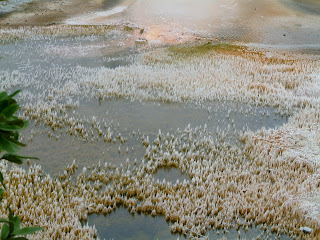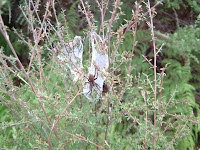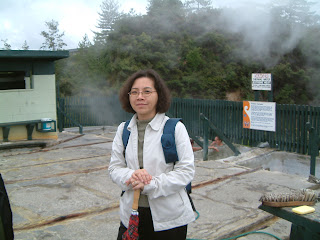
Rotorua is situated at the central part of North Island of New Zealand at the shore of Lake Rotorua which was formed 140,000 years ago. It takes 40 minutes of flight or 3 hours drive from Auckland. The city is surrounded by 16 major lakes created by volcanic activities and were steeped in the legend and history of Maori. It is the home land to one of the largest Maori tribes Te-arawa-iwi and its culture and history infuses the life of the city. Today one third of the population in Rotorua is Maori and many are from the roots of Te-arawa-iwi.
Te-arawa people were the first and early tour guide of the country as since 1800s they had been hosting visitors from over the world, who flocked in for the miraculous healing properties of its natural hot-springs and bubbling mud. Rotorua is the birth place of New Zealand's tourism and most famous and long-standing tourist destination in the country until today.
A kaleidoscope of colors created by the the warm thermal pools. Sulfurous waters are sometimes regarded as useful in the treatment of arthritis and rheumatism and also relaxation.



The intricately carved archway at the entrance to the area of Whakarewarewa depicts the embracing of Hinemoa and Tutanekai, Romeo and Juliet of Rotorua.



There is a Maori Arts and Crafts Institute in the village where skilled Maori carvers and flax weavers could be observed at work. Concerts were performed in a realistic setting inside little Maori village while colonial styled offering unique handicrafts and souvenirs including sheepskin furs



Contemporary food cooked using traditional methods by Maori in the village.



The Maori settlement where tribal people, for generations, used the thermal waters for their living on cooking, washing and heating .


Volcanic landscape provides a dynamic backdrop to many adventurous activities like mountain biking or bating in natural hot pools.



Lake Rotokakahi is more often known as Green Lake due to its jade like clear water. It is privately owned sub-tribe of Te-arawa. No fishing or boating is allowed.


Every geyser, every spring has a curious name with a story attached.



Geyser flat at Whakarewarewa is one of the best field left in the world.


Geysers spout skyward as high as 100 feet and with a thundering sound.


Geothermal hot spots.



Rotorua's healing water was described as Wai-ora-a-Tane meaning Living water of Tane as according to Maori legend the dying moon bathed each month in the great mythical lake of Aewa and received the gift of life to sustain her to continue her journey to heavens.


(1+2) Mud pools bubble and belch. (3) The poison spider black widow.



A soak in a natural hot spring to rejuvenate your spirit.


Thermal pools may look tempting, but look out, some of them are boiling hot.



A steamy walk through Rotorua's boiling landscape.


Rotorua was settled by descendants of voyagers from Hawaiki, homeland of Maori. One of their ancestor arrived in 1350, almost 500 years earlier than the first European Captain Phillip Tapsell, a Danish sailor.



The Bath House at Fenton Street was a sophisticated spa center constructed in 1908. Polynesian Pools next to it, contains several thermal pools each with its own special mineral content and vary temperatures. The most costly one was named after a Father Mahoney who built a tent along the side of a hot spring in 1878 and continuously bathed in the warm water until he had complete relief from his rheumatism.


The bath house houses an art gallery and a local museum for visitors to have a fascinating glimpse into the past of Rotorua.


Nominated by the Bath House is the beautiful public garden area at the end of the street, with memorial stone of Hine-te-Kakara, the daughter of Rotorua's discoverer, whose body was thrown into a boiling mud pool after being murdered.




The rich carvings at Historical Maori village of Ohinemutu which was once the main settlement on the lake.


A View of the town and the rose garden.



Lake Rotorua and Rotoiti were discovered in the year 1350 by a Maori Leader named Ihenga when he was out hunting food for his pregnant wife.


Elegant black swans are among the wild bird life at Lake Tarawera, which is very popular for rainbow trout.m2


The background of Lake Tarawera is the majestic Mountain Tarawera.


Sizable lava stones along the southern side of lakes.



In Rotorua, we were accommodated in a two room unit with an individual indoor hot spring jacuzzi pool and beautiful roses outside the compound.


No comments:
Post a Comment